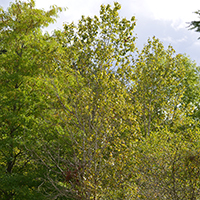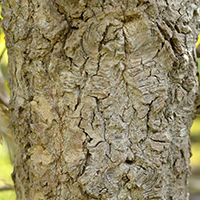What balsam poplar looks like
Size and shape
- Medium-sized tree.
- Grows up to 25 metres tall.
Leaves
- Pointed, shiny, oval-shaped leaves.
- Resin-dotted undersides.
Bark
- Flat, scaly and ridged at maturity.
- Buds are sticky and smell of balsam.
Flowers
- Long, hanging catkins that appear before leaves.
Fruit
- Fluffy seeds disperse in the spring.
Where balsam poplar is found
Balsam poplar grows coast to coast in Canada and everywhere in Ontario except at the northernmost fringe near Hudson Bay. Balsam poplar is one of the hardiest deciduous trees in Canada.
What you need to know to grow balsam poplar
- Moisture: grows best in moist sites.
- Shade: intolerant of shade; grows best in full sun.
- Soil: grows best in rich, well-drained soils.
- Notes:
- balsam poplar can provide a quick shelter for shade-tolerant species that need wind protection to establish, such as hemlock or white pine
- balsam poplar is often planted as a fast-growing windbreak in rural areas and does not root sucker as readily as other species
Benefits and uses of balsam poplar
Wildlife benefits
Balsam poplar trees provide windbreak, shade for grasses and habitat for a variety of wildlife species. Sticky, fragrant buds are a food source for small mammals and birds. Beavers use balsam poplar wood to build dams.
Commercial uses
Wood from balsam poplar is light-weight and can be used for:
- pulp and paper
- boxes and crates
- veneer
Fun facts about balsam poplar
- Bees sometimes harvest the resin from balsam poplar and use it to disinfect their hives.
Updated: May 25, 2023
Published: July 18, 2014




